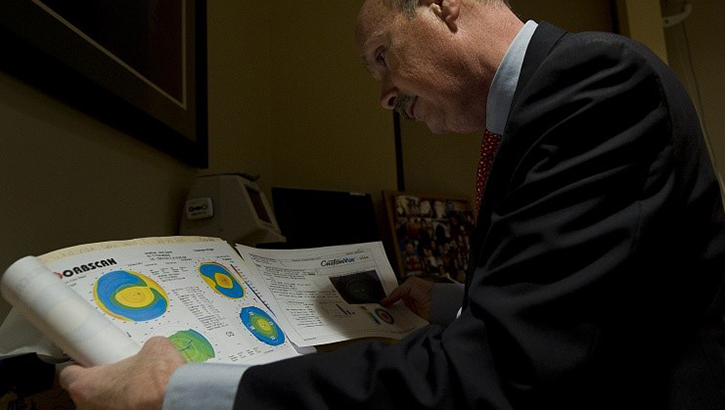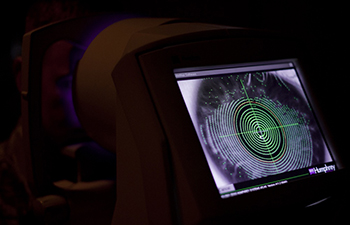Military Laser Eye Surgery: Enhancing Vision Readiness
 James Colgain, 779th Medical Group optometrist, reviews an orbscan and wavescan results at Joint Base Andrews, Maryland. (Photo by: Air Force Staff Sgt. Perry Aston, 316th Wing).
James Colgain, 779th Medical Group optometrist, reviews an orbscan and wavescan results at Joint Base Andrews, Maryland. (Photo by: Air Force Staff Sgt. Perry Aston, 316th Wing).
Maintaining near perfect vision is vital to any warfighter.
While many service members wear contact lenses or glasses, other warfighters find glasses or contact lenses incompatible or difficult in austere environments.
"Vision impacts so much of what we do in the military, and having problems with glasses or contact lenses, especially in a deployed environment, can cause a host of problems," said Air Force Lt. Col. James Townley, refractive surgery consultant.
"Glasses can dislodge, fog or be lost, putting the military member and team at additional risk. Contact lenses are not allowed in deployed conditions due to their propensity for infection. Eliminating the need for distance correction, particularly when service members deploy, avoids these risks."
Twenty years ago, the Department of Defense initiated the Warfighter Refractive Eye Surgery Program. The purpose of the program then, and now is to enhance vision on the battlefield, improve readiness, retain or qualify military members in occupations demanding excellent uncorrected vision, and to make headgear and goggles less burdensome.
This program was initially designed to provide a combat-vision edge to Navy SEALS, Special Forces and other warfighters through a variety of corrective surgery options. Since its inception in 2001, the research, technology and experience have allowed the program to expand and include all active duty service members, including aviators.
Photo refractive keratectomy, or PRK, and laser assisted in situ keratomileusis (LASIK) are available at all 26 military laser centers. This advanced technology enables the correction of most patients with nearsightedness, astigmatism or farsightedness.
However, no procedure currently eliminates the need for reading glasses, which occurs because of aging of the eye, usually when a person reaches their mid-40s.
PRK is a 10-minute surgical procedure that reshapes the surface curvature of the cornea by gently removing tissue with a cool ultraviolet laser. PRK is a very low-risk procedure but can take up to 90 days to completely heal.
LASIK involves creating a surgical flap with a laser on the front of the cornea and then sculpting the underlying surface. This procedure usually takes five to 30 minutes. Recovery time for LASIK is typically a few days to a few weeks.
 A Joint Base Andrews topographer takes a topographic map of a patient’s cornea. This imaging is used for mapping the surface curvature of the cornea (Photo by: Air Force Staff Sgt. Perry Aston, 316th Wing)
A Joint Base Andrews topographer takes a topographic map of a patient’s cornea. This imaging is used for mapping the surface curvature of the cornea (Photo by: Air Force Staff Sgt. Perry Aston, 316th Wing)
Small Incision Lenticule Extraction (SMILE) is a new refractive surgery procedure available at some military refractive surgery centers. Air Force Maj. Bill Gensheimer, chief of ophthalmology at the Warfighter Eye Center at Joint Base Andrews in Maryland, said, "Refractive surgery in the military provides a combat edge in vision. It allows our warfighters and aviators to deploy without glasses and contacts. We now perform SMILE for active duty service members. SMILE offers rapid visual recovery by removing a thin lenticule of tissue from the cornea."
Implantable collamer lenses (ICLs) are also available at some laser centers and are used to correct very high prescriptions when ocular parameters may not be safe to perform LASIK or PRK. This surgery requires placing a small plastic lens inside the eye.
Research and safety:
Active duty service members now have the option to correct their distance vision, if medically and administratively qualified. Thanks to advanced technology and the military's dedication to operational research and safety, refractive surgery has been performed on more than 350,000 service members. According to eye physician and surgeon, Army Lt. Col. (Dr.) Gary Legault, "Refractive surgery consultant for the Army, nearly 95 percent of patients reach correction levels of 20/20 or better, enabling them to perform their combat duties without dependence on glasses. Current wait times for surgery average four to eight weeks, down dramatically from the early days of the program."
How does an active duty member apply for surgery?
The first step is to have an eye exam with your local optometrist. Your eye doctor will help you to contact one of the 26 military refractive surgery centers, usually through their websites, and complete the application. During this process, military members must receive permission from their commander to undergo the procedure, be medically qualified, have a stable eyeglass prescription, and have specific time left on active duty, usually at least six to 12 months.
More details are available at the laser eye surgery center websites.
At the laser surgery center, each surgical candidate undergoes an extensive evaluation, usually lasting about two hours, including dilation of the pupil. "Overall at the pre-operative evaluation, we're trying to look at what's the safest procedure that will provide them their best vision," said Army Lt. Col. (Dr.) Ryan Roberts, director of laser eye surgery at Walter Reed National Military Medical Center in Bethesda, Maryland.
"LASIK and PRK are both excellent procedures, but there are significant differences in visual recovery, with LASIK being much quicker. On many levels faster visual recovery is beneficial, such as quicker return to work," Roberts stated.
"The military's vision standards were once a major potential hurdle for those who wanted to serve in programs that required near-perfect vision. PRK and LASIK eye surgeries, have enabled many individuals to join and qualify for specialized careers such as aviation, Special Forces and other "tip of the spear" professions, said Army Maj. (Dr.) Paul Houghtaling, eye physician and surgeon. "It has been a new paradigm for our military members," he added.
"During ROTC [Reserve Officer Training Course], I realized that my dependence on glasses, since age 10, would keep me from reaching my dream of becoming a naval aviator," explained Navy Lt. Cmdr. Wendy Zehner, a Naval aviator who had LASIK in 2014, and is currently stationed at Naval Air Station North Island in California. "After LASIK, I went from barely seeing 20/200 to seeing 20/15 without glasses! It was life changing to realize after the surgery that nothing would now hold me back from my dreams. After graduation, I was able to enter training and today serve the Navy as a lieutenant flying the MH-60R helicopter. I can more efficiently and safely do my job because of my improved vision."
"All service members who are still wearing glasses or contact lenses should be evaluated for refractive surgery," Townley said. "The longer they go without it, the less time they have to enjoy life without glasses...we are ready when they are," he stated. If you are interested in laser eye surgery, and are active duty, your next step is to speak to your military optometrist and/or visit one of the twenty six military laser surgery center websites.